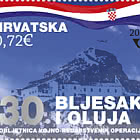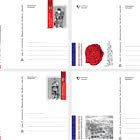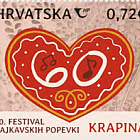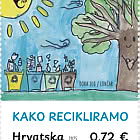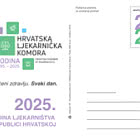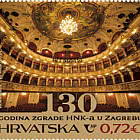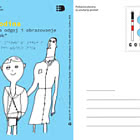Motif: a wax figure of Jesus from the Immaculate Conception of the Blessed Virgin Mary Church in Lepoglava currently displayed at the Diocesan Museum at the Archdiocese of Zagreb The stamp was issued in a 20-stamp sheet and a 10-adhesive stamp booklet, and Croatian Post also issued a First Day Cover (FDC). This stamp was issued in cooperation with the Parish of the Immaculate Conception of the Blessed Virgin Mary in Lepoglava. Prior to the time of when the northern custom of decorating Christmas trees became a part of our holiday tradition, in many areas, especially in the south, the centre of the holiday had been the image of the Infant Jesus. Made of wax or wood, naked or clothed, it was actually a holly doll praising new life, reminding of the sins of brazen wealth and virtues of modesty and humility. Sometimes, there would be a City of Bethlehem sprawling around the Infant Jesus. Sometimes the city would have a few details and, at other times, it would depict a whole small city bustling with everyday life – people earning their bread in honour of Jesus. However, even without the additional details, the child figure alone would stir up plenty of emotions. Some such small holly images from the past century are renowned in Europe, such as the Infant Jesus of Prague or the one in the Roman Church of Santa Maria in Aracoeli. That Christmas figure was especially celebrated in Dubrovnik. It was named “Bambin“ after the Italian word “bambino“ (child). Nearly every home had a Bambin and one of the best known and the few preserved ones, was the one owned by Anica, Ruđer Bošković’s sister. Anica left her Bambin to her nun through her will. Nowadays, it can be found at the Church of Sigurata. The Infant Jesus on this year's Croatian Christmas stamp is from the northern part of Croatia. The Ursuline nuns from Varaždin created it with their skilled and patient hands at the beginning of the nineteenth century. In the past, it was located in the parish church in Lepoglava and then it ended up at (nowadays almost virtual) the Diocese Museum. This splendid museum was formed by Kamilo Dočkal, an all-deserving canonist, between the two wars. Among his other feats, Kamilo also established a contact network among the vicars from all parts of Croatia. He spurred them to divert historic sacral art pieces, those threatened by a loss of function for whatever reason, to that museum. He also increased the fundus through his European travels. He documented all pieces and scientifically processed them with great care so that the entire museum unit remained renowned for his archive. A part of that unit is also this delightful Infant Jesus in his theca – a small household altar. Gentle and devout hands gave the Infant Jesus everything that the cold cave or stable bereaved him of. Instead of a cold winter night and sparse hay, his surrounding now is full of flowers of all luxurious colours. It is as though he descended to earth taking a piece of heaven with him. Instead of a diaper that could barely cover him and keep him warm, he is now dressed in a rich dress that wants to give the impression of silver, jewels and pearls. He has been crowned the same way. However, two details can especially make you look more carefully. His underclothes peak out from under his dress – the lace of Lepoglava. This way, the Infant Jesus stored a hint about his homeland in his heavenly herbarium. This is where he was adopted and this is where his Bethlehem also is. At the very bottom of the scene, under the crown and apotheosis, are small remains of his humble birth – the sheep from that song with verses, when translated, go like this: “I also want to be your sheep“. Those are sheep who follow their shepherd. But those are also those real sheep of those real shepherds a star brought to the nursery. Those are the sheep from the real world whose smallness and warmth has not been forgotten underneath the jewels and the crown. And what good would Christmas be if we did not feel the warmth and if we were not small? Željka Čorak, Ph. D., science advisor-emerita at the Institute of Art History











